Microbiome and Metabolome Features Characterized for the Cardiometabolic Disease Spectrum
Posted on 28 Feb 2022
Scientists have already discovered that the gut microbiome is altered in people with chronic heart disease. They subsequently identified compounds that are produced by the diseased microbiome, for instance a bacterial compound called trimethylamine (TMA) that after modification in the liver of the human host causes arteriosclerosis.
The human gut contains trillions of bacteria, collectively called the gut microbiome, which may have positive and negative effects on human health. When in balance they function as an inner chemistry factory producing numerous compounds that promote good health.

However, an unhealthy lifestyle can disrupt the balance, leading the microbiome to instead produce compounds that may trigger multiple non-communicable chronic disorders in people at high genetic risk, including myocardial infarction, angina or heart failure. Scientists have already discovered that the gut microbiome is altered in people with chronic heart disease.
A large team of international scientists including those at the University of Copenhagen (Copenhagen, Denmark) recruited 1,241 middle-aged people from Denmark, France and Germany including healthy individuals, individuals with obesity and type 2 diabetes, but lacking a diagnosis of heart disease, and patients with either myocardial infarction, angina pectoris or heart failure. Fasting plasma glucose, total and HDL cholesterol, triglycerides, creatinine and HbA1c levels were measured using standard enzymatic methods.
Alanine aminotransferase, aspartate aminotransferase and γ-glutamyltransferase were measured by enzyme-coupled kinetic assays. Ultra-sensitive C-reactive protein was measured using an Image Automatic Immunoassay System (Beckman Coulter, Brea, CA. USA). Microbial loads of fecal samples were processed and analyzed using a C6 Accuri flow cytometer (BD Biosciences, San Diego, CA, USA).
The scientists found that about 75% of microbiome and metabolome features that distinguish individuals with ischemic heart disease (IHD) from healthy individuals after adjustment for effects of medication and lifestyle are present in individuals exhibiting dysmetabolism, suggesting that major alterations of the gut microbiome and metabolome might begin long before clinical onset of IHD. They further categorized microbiome and metabolome signatures related to prodromal dysmetabolism; specific to IHD in general or to each of its three subtypes or related to escalation or de-escalation of IHD. At higher microbiome architecture levels, there was a significant shift from the Bacteroides 1 and Ruminococcus enterotypes toward the low bacterial cell-count-associated Bacteroides 2 as the disease worsened.
Oluf Borbye Pedersen, MD, A Clinical Professor and a senior author of the study, said, “We found that about half of these gut bacteria and blood compounds were modified by drug treatment and not directly related to heart disease or the early disease stages like diabetes or obesity occurring prior to diagnosis of heart disease. Among the remaining half, about 75% of the disturbances of the gut microbiome occurred in the early disease stages of overweight and type 2 diabetes, many years before patients noticed any symptoms of heart disease.”
The authors concluded that at prodromal dysmetabolic stages and at both early and late clinical manifestations of IHD, multiple de-confounded microbiome and metabolome alterations are present, reflecting distinct metabolic pathways. Several of these are modifiable and might be targets for future mechanistic studies and clinical trials aiming at IHD prevention. The study was published on February 17, 2022 in the journal Nature Medicine.
Related Links:
University of Copenhagen
Beckman Coulter
BD Biosciences













